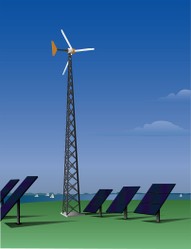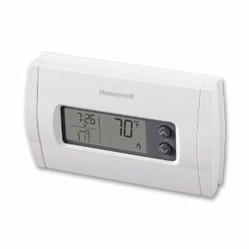Your choice of a green energy system will depend a great deal on what you have available to you. Generally speaking, your options for producing electricity in a renewable manner will consist of solar, wind, a combination of these two or micro hydropower. Once you have determined what systems are available to you, you'll need to look into matters such as cost, financing options, placement of the system and codes and regulations that might apply to the installation of a green energy system. You also need to decide whether you want to go completely off the grid with your green energy system or stay connected to the grid.

Choosing A Green Energy System For Your Home Can Be Easy
by SallyTX
If you want to create your own electricity at home, you have quite few options these days. This article explores the basics of a few of the more popular green energy system choice
Sun, Wind and Water! Great Green Energy Choices
Taking it all into consideration...
Solar energy systems are the most popular of the choices available today. They are reliable and free of pollution and you can create a great deal of energy for home use. If you want to move far out into the countryside where there are no power lines, a solar energy system is probably the perfect choice for you. Solar energy systems are readily available, and a good system can fit handily on the average rooftop.
Another good choice in green energy is a wind energy system. Wind energy systems are actually very easy to install and very economical. Additionally, if you're off the grid a wind energy system can create electricity and help with pumping water. The downside of a wind energy system is that it may take quite a bit more space than a solar energy system.
Solar and wind systems can also be neatly combined into a hybrid system that takes advantage of both the power of the sun and of the wind. This is nice insurance that power will always be available because wind power and sun power tend to be available at different times of the day and different times a year.
Another excellent choice for a remote location with running water, such as a stream or river, is a micro-hydropower system. This sort of system is very powerful and is often used to power remote resorts or large ranches.
Will You Stand Alone or Stay Connected?
Once you have done some in depth research on each of these choices, you'll need to decide whether you want a standalone system or a grid connected system. Of course, if your home is located in a very remote area the choice is made for you! If you are in an urban area, there are some advantages to staying connected to the grid. In the unlikely event that your green energy system does not produce enough electricity for you, you'll always have your local public utility as a fallback system. In the very likely event that your system produces more electricity than you need, you can make money by selling that electricity back to your public utility!
One downside of staying connected is that it may cost you a bit more at the outset. There is a little bit more equipment involved in remaining connected than in building a standalone system. When you make this choice, you'll want to confer with a licensed and experience electrical contractor or general contractor. In any event, your whole system must be correctly installed for safety and efficiency. If you decided to stay connected to the grid, it is extremely important that your connection with the grid be done exactly right to be able to transmit electricity safely both from the public utility to your system and from your system back to the public utility.
What permits will you need?
Another thing you'll want to keep in mind when selecting a green energy system is the type of permits and easements necessary in your area. You may wish to apply with your local authorities for an easement that guarantees that no structure will be created that will block your ability to produce and use green energy. This is a smart idea because this easement will become a permanent part of the deed to your property. If you sell your property, the easement could add to the value and may be a good selling point.
When you're checking into easements, you must also be sure that there are no local ordinances or covenants that would prevent your being able to install a green energy system or limit the type of system you are allowed to install. This may affect your choice of the type of system you choose to install. For example, some communities may not allow wind turbines but would have no problem at all with solar energy panels. It's important that you find these things out before you invest in a green energies.
Two money-saving facts to remember!
It may cost you a bit of an investment to install a green energy system in your home, but just keep two facts in mind:
1. You will need to use electricity for the rest of your life.
2. You may be able to sell electricity back to your power grid.
These two money-saving facts make it easy to see that choosing to convert your home to a green energy system is a very wise choice, indeed!
Clean, Renewable Energy Saving and Creating Tips!
For more information about natural energy solutions, you may enjoy...
Creating Electricity & Saving Our Nation & the World Naturally
Even more about natural energy solutions!
Simple Solar Solutions You Can Do To Help The Earth And Save Money Now!
Easy things you can do to save money and energy at home!
There's always something new under the sun with green energy systems!
 | DIY Projects for the Self-Sufficient Homeowner: 25 Ways to Build a Self-Reliant Lifestyle Build your way to a more self-sufficient lifestyle with step-by-step projects for backup and supplementary utilities--including independent water, heat, and electricity--growing... |
 | Wind Power For Dummies The consumer guide to small-scale wind electricity production!Maybe you're not T. Boone Pickens, but you can build your own home-sized wind-power empire right in your back yard.... |
 | Solar Power for Your Home (Green Guru Guides) Easy, inexpensive, do-it-yourself solar energy projects Featuring step-by-step instructions and useful photos and illustrations, this hands-on guide is filled with solar energy ... |
 | Passive Solar House: The Complete Guide to Heating and Cooling Your Home Revised and Expanded Edition-Includes CD-ROM with Custom Design SoftwareFor the past ten years The Passive Solar House has offered proven techniques for building homes that heat... |
 | The Passive Solar House: Using Solar Design to Heat and Cool Your Home (Real Goods Independent Li... Finally there is a contemporary book that demonstrates the potential for heating and cooling a home with free energy. This new volume is a welcome addition to the canon of indis... |
You might also like
Getting Through a Power OutagePower outages are inconvenient, and can last for some time, depending on the ...
The Honeywell RTH230B 2 day Programmable Thermostat - Is it th...The Honeywell RTH230B Thermostat is a programmable piece wherein programming ...



 What You Need To Know About Cleaning Your Solar Panelson 04/23/2013
What You Need To Know About Cleaning Your Solar Panelson 04/23/2013
 Easy Tips To Go Green Without Any Painon 05/19/2012
Easy Tips To Go Green Without Any Painon 05/19/2012



Comments
Yes, and they get less and less expensive and more and more efficient all the time. I hope we can soon be free of our absolutely unnecessary addiction to petroleum products! Thanks for your comment! ;D
I wouldn't mind having a solar panel on my roof. It seems to be the least intrusive form of green energy.